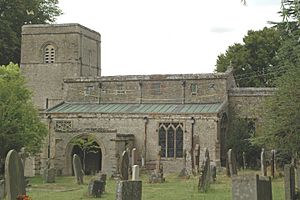Church of the Annunciation to the Blessed Virgin Mary, Souldern facts for kids
Quick facts for kids Church of the Annunciation to the Blessed Virgin Mary |
|
|---|---|
 |
|
| 51°58′54″N 1°14′19″W / 51.98167°N 1.23861°W | |
| Location | Souldern, Oxfordshire OX27 7HU |
| Country | England |
| Denomination | Church of England |
| Website | Cherwell Valley Benefice |
| History | |
| Dedication | Annunciation to the Blessed Virgin Mary |
| Architecture | |
| Style | Norman, Decorated Gothic and Perpendicular Gothic |
| Years built | circa 12th - 16th centuries |
| Administration | |
| Parish | Souldern, Annunciation to the Blessed Virgin Mary |
| Deanery | Bicester & Islip |
| Archdeaconry | Oxford |
| Diocese | Oxford |
| Province | Canterbury |
The Church of the Annunciation to the Blessed Virgin Mary is a special church in the village of Souldern, Oxfordshire, England. It's part of the Church of England. Souldern is about 7 miles (11 km) northwest of Bicester and southeast of Banbury.
Contents
A Look at the Church's History
Nobody knows exactly when this church was first built, but we know it existed by 1161. The oldest parts you can see today are from the 12th century. These include the Norman tower, part of the north wall of the main church area (called the nave), and the north doorway. The south side of the church also had an aisle added before the end of the 12th century.
Changes Over the Centuries
The church's first chancel (the part near the altar) might have been round, but it was later replaced with a larger, rectangular one. This new chancel was built with a new archway leading into it. Some historians think this happened in the early 1200s, while others believe it was closer to 1300.
In the early 1300s, the south aisle was rebuilt to be much bigger. It was designed in the Decorated Gothic style, which is known for its fancy decorations. Two old Norman columns from the original aisle were reused to hold up three new pointed arches. One interesting detail is that a Norman capital (the top part of a column) was turned upside down to become the base of one of these columns! At the same time, new Decorated Gothic windows were added to the old north wall of the nave.
Later, in the late 1400s or early 1500s, a clerestory was added to the nave. This is a row of windows high up on the walls, which helps bring more light into the church. This addition was in the Perpendicular Gothic style, known for its tall, straight lines.
Repairs and Rebuilding
By the early 1700s, the church was in good shape. However, by 1775, the chancel was falling apart, and its roof had collapsed. The Rector (the priest in charge) had the old chancel taken down and a much smaller, low-roofed one built instead.
In 1815, a gallery was added at the west end of the church, but it was removed in 1878. Later, in 1896-97, a famous architect named Ninian Comper rebuilt the chancel again in the Gothic Revival style, making it look more like the original Gothic design. In 1906, another architect, G.F. Bodley, took down and rebuilt the Norman tower and its archway.
Church Bells
Back in 1552, the church's belltower had three bells, plus a smaller Sanctus bell. One of those original bells is still around today, though it was recast (melted down and reshaped) in 1910.
Three of the current bells were made by Henry I Bagley in the 1600s. The fifth and tenor bells were cast in 1631, and the third bell in 1635. The treble and second bells were made in 1907, and the fourth bell was recast in 1910. This completed the current set of six bells, which are used for change ringing. The church also has a Sanctus bell that Henry I Bagley cast in 1665.
Who Owned the Church?
The right to choose the priest for the church, called the advowson, was given to Eynsham Abbey (a monastery) by Jordan de Say in 1161. He owned the land around Souldern. The abbey kept this right until 1539, when monasteries were closed down in England.
After that, the advowson changed hands many times. King Henry VIII sold it in 1544. It was then owned by different families and even claimed by someone who was later executed for treason. Eventually, in 1623, the Crown (the King) gave the advowson to John Williams, who was a bishop. He then gave it to St John's College, Cambridge.
There was a dispute over who truly owned the advowson for a while, but in 1662, the Rector of Souldern gave his claim to St John's College. This finally settled the argument. St John's College still owned the advowson in 1955.
Part of a Larger Group
The Church of the Annunciation is now part of the Cherwell Valley Benefice. This means it works together with other churches in nearby villages like Ardley, Fritwell, Lower Heyford, and Upper Heyford.
The Old Rectory House
The church had a rectory house, where the Rector lived, that was built before 1638. It even had fishponds stocked with carp by 1723! The famous poet William Wordsworth stayed there in 1820. After his visit, he wrote a sonnet (a type of poem) called A Parsonage in Oxfordshire. In another sonnet, he described the house as "this humble and beautiful parsonage." Sadly, this historic house was taken down in 1890 and replaced with a new one designed by architect E.G. Bruton.



